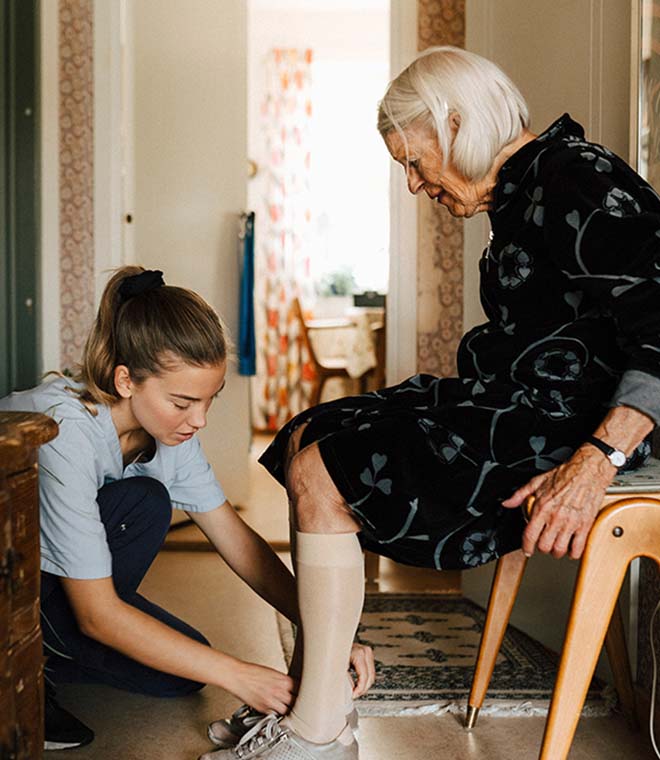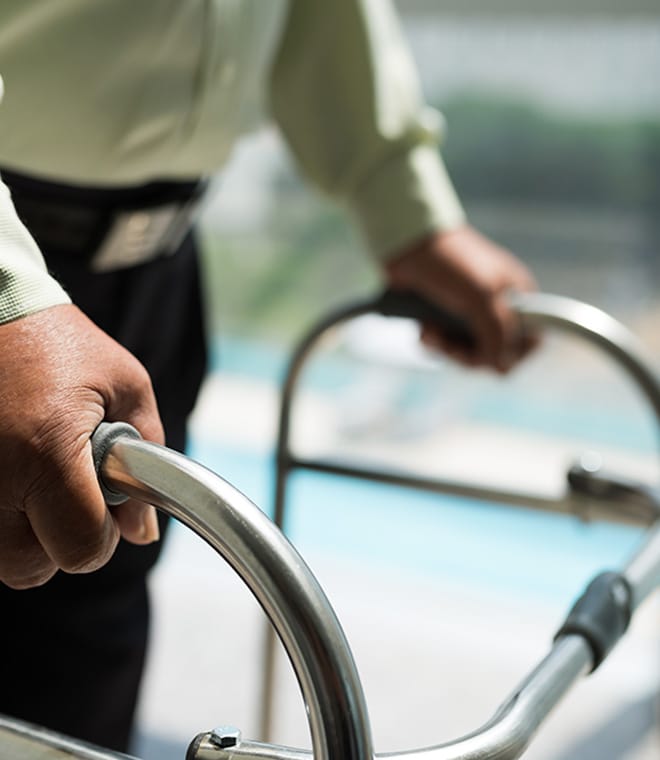Wellness
Bathroom safety: Providing a safe environment as a caregiver
By Nancy Kupka, PhD, RN Jun 18, 2025 • 8 min
The risk of slip and fall accidents increases with age. In fact, more than 25% of people over the age of 65 suffer fall accidents each year, according to the National Institute on Aging. While falls can occur in any part of the home, the bathroom is an area of particular concern. Fortunately, you can take steps to protect your loved ones and help them move more independently in the bathroom with bathroom safety products.
1. Shower seats: Seniors and those with limited mobility may lose their balance and fall while showering. There are three main options for shower seats:
- Showers with seat areas built in: By renovating the bathroom, you can add a walk-in shower with a seat or a shower stall with seat. With these options, the seat is part of the shower wall.
- Wall-mounted shower seats: A wall-mounted shower seat rests on two legs and is anchored to the wall of the shower with hardware. Some models are foldable shower seats that fold against the wall when not in use, providing more space for individuals who do not require shower seating.
- Freestanding shower seats: Freestanding shower bench seats can be removed completely from the shower. They consist of a sturdy seat positioned on four legs with non-slip grips. Some shower bench seat models fold up for easy storage between uses.
2. Transfer benches: Slip and fall accidents can occur when people with limited mobility are getting in and out of the bathtub. A tub and shower transfer bench is designed to help one get in or out of the shower or tub more easily. Bath transfer benches are long bench seats. One end of the bathtub transfer bench is outside of the tub, while the other end is inside. As a result, a user can sit down on one edge of the bathroom transfer bench, and then slide over into the tub for bathing. After a bath, the user is then free to slide back over and stand up. Make sure the seat easily clears the top of the bathtub so that it is stable when in use.
3. Bath lifts: Individuals can transfer in and out of the tub with bath lifts. A bath lift is a chair that is positioned inside the bathtub. The seat is motorized, allowing it to raise and lower with the push of a button. Users can raise the seats when they’re ready to get into the tub, lower them to bathe and then raise them again when the bath is finished.
4. Walk-in showers: Specialty walk-in showers are designed without curbs or with very low curbs to step over, so an individual walks in rather than lifting their leg over a tub. These can be purchased with or without doors, and many have safety features like seats and grab bars built in. Many hotels offer some rooms with walk-in showers, so you can request an accessible shower if traveling.
5. Walk-in bathtubs: Specialized bathtubs called walk-in bathtubs allow an individual to step through a door, sit on a bench and close the door before filling the tub with water. Before leaving, the tub is emptied, and the person steps out. These tubs come in a variety of shapes and sizes and may, or may not, have additional safety features, like grab bars, built in. If this option is chosen, check the capacity of the hot water heater in the home to assure it is sufficient.
6. Raised toilet seats: Transferring to and from the toilet can be difficult for a person with limited mobility. Raised toilet seats address this problem by reducing how much a user needs to bend to sit down. You can purchase stand-alone raised toilet seats or raised toilet seats with arms that give users a place to grip when sitting down and standing up. Some raised toilet seats are adjustable to accommodate people who need different heights.
If you are replacing your toilet, you can purchase a comfort height toilet, which has a seat that is a few inches higher that the average toilet. These are often also elongated, which gives the user a little more room for hygiene.
7. Grab bars: Another helpful option is grab bars. These are bars that are anchored to the bathroom wall in areas where people with limited mobility may need assistance with transferring or help to maintain balance while standing or maneuvering. These wall-mounted grab bars should be made of heavy gauge steel and installed according to the manufacturer’s directions for firm, solid support. It can be helpful to have grab bars near the toilet for added safety. A senior can hold on to the bars when sitting down or standing up.
In addition to a toilet grab bar, you should also install a shower or bathtub grab bar in the bathing area to help get in and out of the tub or shower. Toilet, tub and shower grab bars can be installed horizontally or vertically. It is not suggested to install grab bars for shower, tub or toilet areas diagonally since the hand may slip.
8. Commodes: A bedside commode can eliminate the need to venture to the bathroom when a person with limited mobility needs to use the toilet. A commode chair consists of a seat flanked by grab bar arms. Waste is collected in a pan that can be removed and emptied into the toilet for disposal.
9. Safety bath mats: Slippery surfaces contribute to falls in the bathroom. A nonslip mat can be applied to the floor inside the tub or shower, on the floor directly outside of the tub or shower, and in other areas of the bathroom where water often collects. A nonslip bath mat features suction cups on the bottom that secure it in place. Bath mats have a specially designed surface that provides traction underfoot. Purchase one with drain holes to avoid mold and mildew growing under the mat. Do not place plain throw rugs in the bathroom, as they can cause falls.
Choosing bathroom safety equipment
Whether you’re shopping for grab bars for showers, tub transfer benches or shower seats, it’s important that you read the descriptions for products carefully. Many pieces of bathroom safety equipment have a maximum weight capacity rating, so you’ll need to choose something that is strong enough to support your loved one. Once you receive your home safety equipment, read the installation instructions included carefully and follow them closely. It may be helpful to hire a professional to ensure products are installed the right way. No bathroom safety aid can work properly if it is installed or assembled incorrectly.
Updated by Rebeca Thomas RN, BSN, June 2025.


